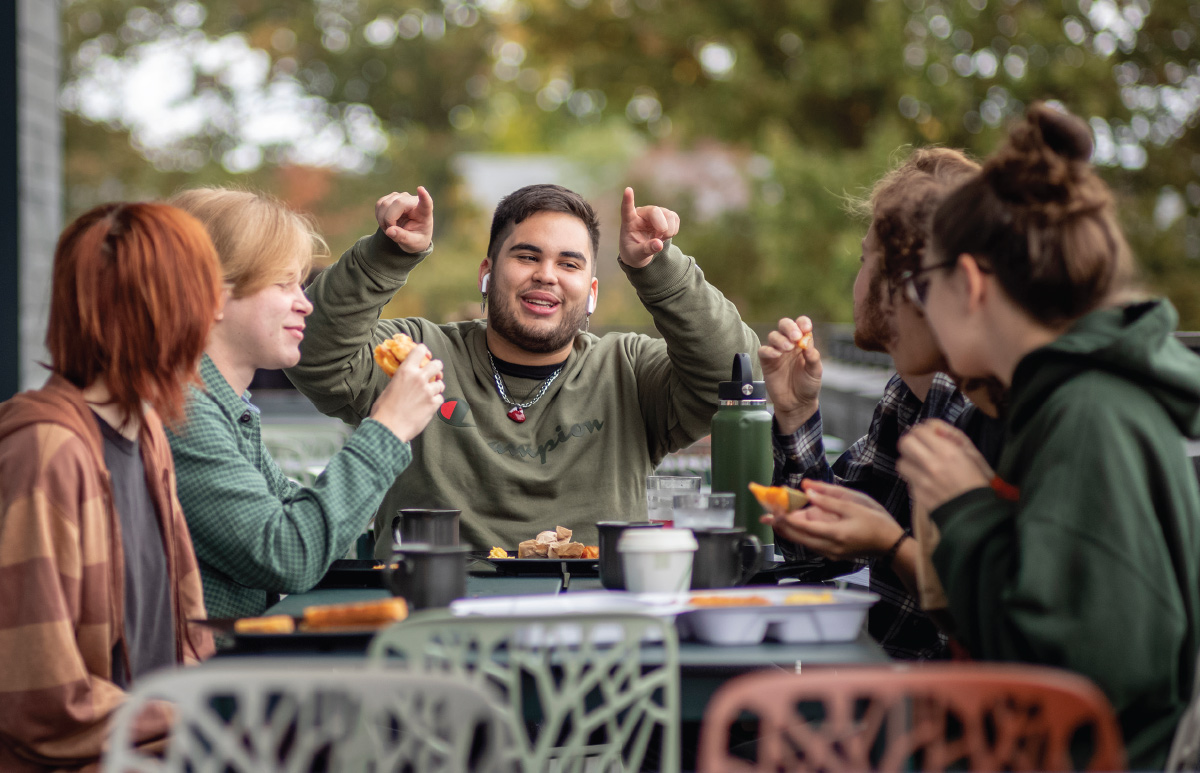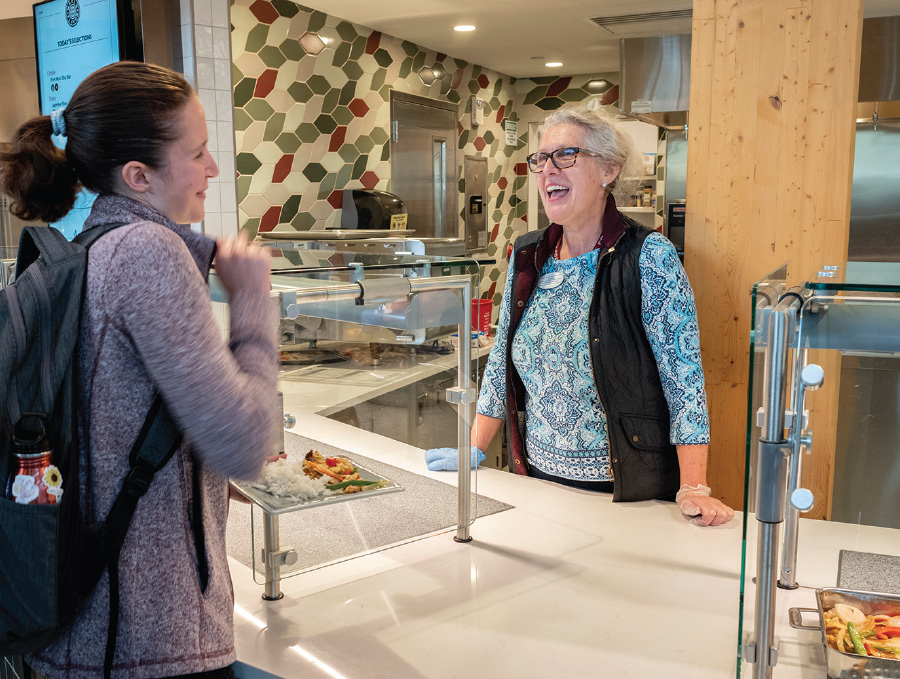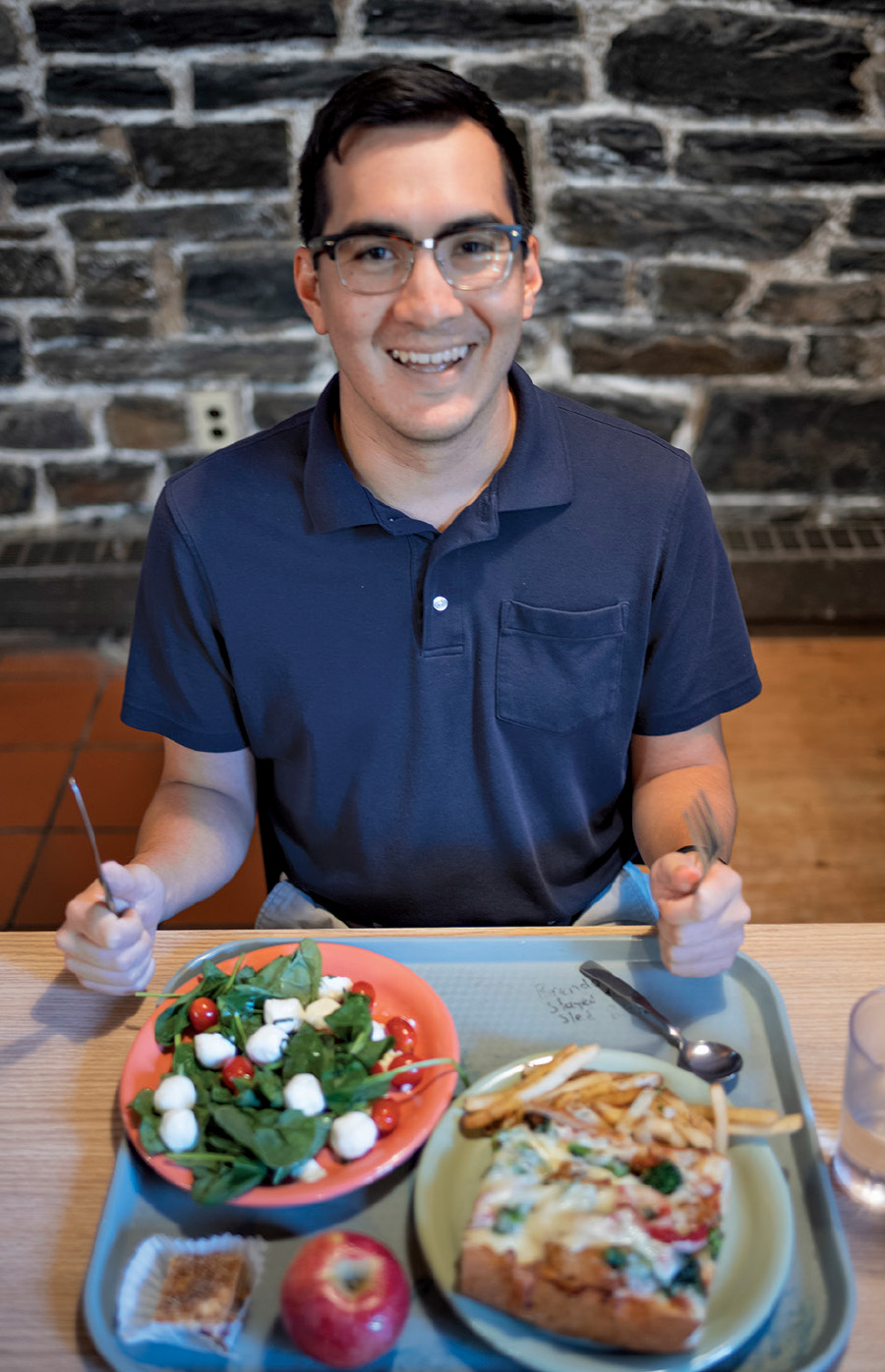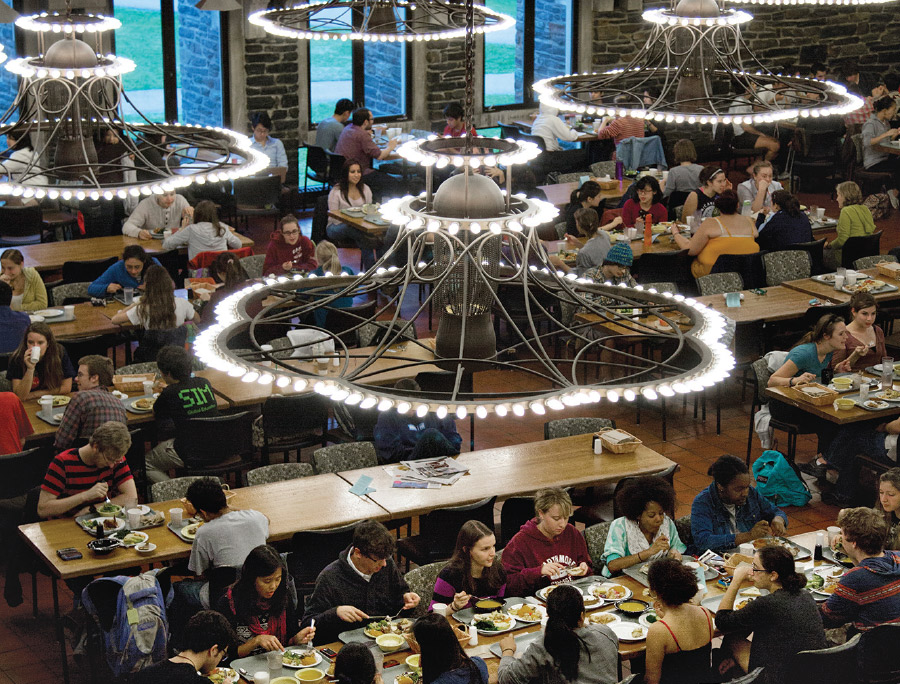
Digging In
photos by Laurence Kesterson

Over 50 years later, Smith’s observation remained apt: long lines snaking out of the servery into the foyer, tight corners that felt perilous to navigate during peak traffic, limited hours for evening meals, and a lack of natural light all made for a less-than-ideal dining experience.
It was clear that Sharples, originally designed to accommodate around 900 students, could no longer meet the needs of the campus community of more than 1,600 students. Thus, the Dining Center was born.
As part of the larger Dining and Community Commons (DCC) project, the Dining Center brings to campus a reimagined dining experience grounded in Swarthmore’s longstanding values of sustainability, community, and inclusivity.
Eating Green
“Our pledge of carbon neutrality was a priority that informed the design from the beginning,” says Associate Vice President for Sustainable Facilities Operation and Capital Planning Andy Feick. “Every decision was made through a sustainability lens, from using sustainably harvested mass timber instead of steel for the building’s structure to eliminating trays in the dining operation. With this building, Swarthmore College aims to set a new standard for sustainable dining.”
“Swarthmore is very fortunate to be able to do these projects, but also to be able to serve as an example,” says Swarthmore’s Senior Project Manager Susan Smythe. “Not every institution can afford to do this, and I think it’s really important to show that even a smaller project could be possible.”
Other sustainable features include an all-electric kitchen, long-lasting terrazzo floors, stormwater management and recapture, and a trayless policy that is estimated to save approximately 22,000 gallons of water per year.
Additionally, Smythe notes that project leaders took great care to avoid items on the LBC “red list,” which contain materials that are known carcinogens or the production of which is hazardous to the health of the environment.
A Seat at the Table

Access Points


Comfort Food
It’s a lot, though I’m sure many Swatties have had more.
Though I am also the proud owner of 50 decommissioned Sharples trays I won in an auction, I don’t think I can provide the final word on the storied institution that is our beloved Gothic ski lodge of a dining hall; rather, I hope that my reflection, much like Sharples, has something for everyone.
I have always been fascinated by food, which led me to Professor Allison Dorsey’s first-year seminar, History of Food in America. Among other things, I came away with a deeper appreciation for how the social aspect of eating is universally important.
At its most basic, food is a requirement for survival, but of course, it’s so much more: It is a foundational part of how we build relationships and community. Many of my favorite memories from Swarthmore revolve around eating, and Sharples is central in almost all of them (late-night student specials from Renato’s notwithstanding). I remember when Chris Magnano ’14, my sophomore roommate, baked focaccia for my birthday and I brought the leftovers to Sharples. I will never forget how thrilled my friends were to receive an unexpected gift of delicious bread and I’m reminded of it these days whenever I make a batch of bagels to share.
I remember heading to Sharples after frisbee practice on a particularly gorgeous day. We sat outside in a giant circle with the women’s team, the Warmothers, and talked or threw a disc until it got dark, hanging around because we didn’t want to leave each other’s company and return to the demands of a Swarthmore education.

Instead of regaling you with dozens of other hyper-specific Sharples recollections, I leave you with this: Sharples may be central to many of my fondest memories, but it is, in the end, only a building. What made my time there special was the people: my friends, teammates, classmates, and most of all the dining staff, who worked tirelessly to nourish and support students going through intellectual and social transformations we weren’t always ready for.
These things surely will continue in the new Dining Center and I hope it fosters memories like mine for generations of students to come. Nothing is ever truly gone if we choose to remember it. Incredibly, that lot of 50 trays included the only one I ever wrote on. It’s faded, but you can see the outline of the Sierpiński triangle with “#YOLO” scrawled in the middle. It’s an oddly poignant reminder that Sharples no longer serves as a dining hall, but our memories of it will live forever.
“For many of us, the Sharples kitchen felt like being in a cave,” says Swarthmore Dining Director Linda McDougall. “It’s really refreshing to actually see what’s going on outside and for students to see and have a better appreciation of how hard people work here, and how passionate they are about what they’re doing.”
In addition to Fired Up, the stations are Field of Greens, a make-your-own salad bar; Daily Kneads, which serves desserts, baked goods, and ice cream; World of Flavor, highlighting global cuisines such as Italian, Indian, and Caribbean; The Classics, for homestyle “meat and potato” offerings; Verdant & Vegan, which has fresh, flavorful, meat-free and dairy-free options; Spice of Life, for Mediterranean and Middle Eastern cuisines; Grillin’ Out, offering grilled sandwiches, fries, and more; and The Free Zone, a space free of all of the top nine food allergens, including sesame.
“It’s really nice to have a new space with so many options, especially from around the world,” says Daniela Padron Castillo ’24. “I’m hoping it will offer food from Mexican culture because that’s what I’ve been missing.”
“Balance” also feels fitting to describe the larger DCC project because of the way it combines the old and the new: The interior of Sharples will be renovated and live on as a central hub for student activity with flexible spaces for meeting, socializing, and community-building. The project, which is scheduled to be completed in the fall of 2023, has the potential to redefine the College’s social experience in the same way the Dining Center has.
“I think the DCC is going to facilitate club and organization activities, class functions, and other social events that Swarthmore often lacks,” says Humphreys. “This will be a great opportunity to not only engage with the community that already exists, but also make it even larger by welcoming everyone in.”